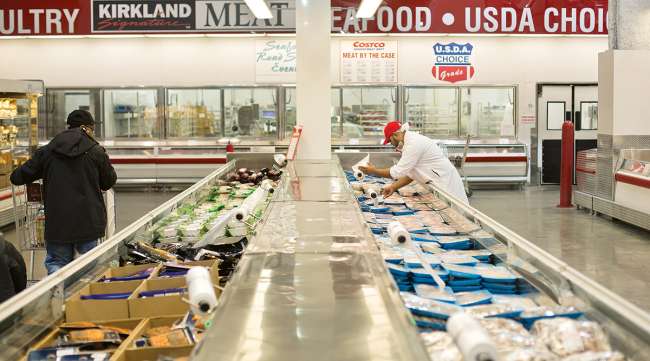Staff Reporter
Working Group Tackles COVID Food Supply Chain Disruptions

[Ensure you have all the info you need in these unprecedented times. Subscribe now.]
Leaders in the food transportation sector are working together to share lessons learned during the coronavirus pandemic.
What began as an informal collection of key players sharing information has grown into a formal working group tasked with addressing challenges across the food supply chain, fixing problems and endeavoring to prevent future disruptions.
“What I found during the different conversations with each sector was they were all doing something, but it was segmented within their own sector,” said Jon Samson, executive director of the Agricultural and Food Transporters Conference at American Trucking Associations, which is spearheading the working group. “There weren’t a lot of conversations, and there were gaps within that food supply chain. The goal of the group was to share information.”

Samson
Around March, Samson told Transport Topics that one of the first issues on the docket was addressing food waste caused by the pandemic. For example, in the early days of local lockdowns, milk was being dumped and beans were being sown back into fields.
“I reached out to a handful of folks within the supply chain, like the dairy side and livestock side then also food production, food manufacturing and food shipping,” Samson said. “That smaller group turned into a larger group pretty quickly.”
FMI, the Food Industry Association, had already created informal and formal links between food service distributors and retail members to bridge some communication and supply gaps, and also facilitated forums so members could learn from each other. Marjorie DePuy, FMI senior director of supply chain and sustainability, told TT that the working group, “started as a response to the perishables problem, when there was a visible oversupply of certain commodities bound for food service,” and grew from there.

DePuy
“It was helpful to share information with others on the calls so we could be aware of the situation in various sectors of the industry and learn about resources where they existed,” she said.
The U.S. Department of Agriculture and the Federal Emergency Management Agency also got involved. The working group helped bridge communication gaps between the government, producers, trucking and charities such as Feeding America so food was being transported to where it was needed.
“We worked with the USDA on their Farmers to Families Food Box program to get them linked up with people and get them started,” Samson said. “We worked with FEMA, [which] was working on getting food assistance to needy families.”
Involvement from the federal government led to others being pulled into the effort.
“We participated in the working group calls to get a better understanding of partnership opportunities across the supply chain,” Meghan Stasz, vice president of packaging and sustainability at the Consumer Brands Association, told TT. “Collaboration and information sharing was critical in the early stages of the pandemic, as different organizations and stakeholders worked to find quick solutions to immediate supply chain challenges.”
The Consumer Brands Association helped connect the working group participants to members of its Food Waste Reduction Alliance. It also introduced the working group to a blockchain organization called Connecting Food, which has provided digital auditing capabilities to identify supply chain anomalies.
“The initial step last spring was to just stop the bleeding,” Samson said. “Longer term, there has been a fair amount of academic and private work that is being done.”
On the academic side, consultant Dan Holladay had already been working with the University of California on a technology road map for the agriculture industry when he got involved in the group.
How did turkey-to-table change this year? What obstacles were suppliers going through to get turkeys to grocery stores? Join us as we talk with J.J. Smith, President of Valley Proteins, about how staying open-minded and flexible helped his business of delivering turkeys persevere. Hear a snippet, above, and get the full program by going to RoadSigns.TTNews.com.
“COVID hit, so I backed up and said we probably need to reorganize this and focus on the biggest crisis areas right now, and that was the food supply chain disruptions,” Holladay said. “That’s when I shifted it over to that.”
Holladay said the goal now is to pull together the work being done and help transform supply chains for the future. That could include formal documentation of what’s been learned.
“It started evolving to where we want to hold a formal workshop,” Holladay said. “The goal is to make it very formal. In fact, we want to make it into a document that the U.S. industries and ecosystems are aligned with.”
Want more news? Listen to today's daily briefing:
Subscribe: Apple Podcasts | Spotify | Amazon Alexa | Google Assistant | More





